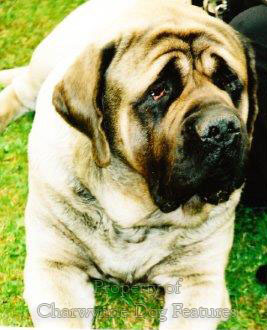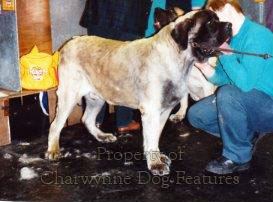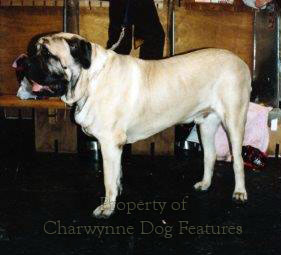287 English Mastiff
THE LEAL AND TRUSTY MASTIFF
by David Hancock
 There is plenty of evidence to show that the Mastiff, the English breed of that name, has not always been enriched by the breeders who bred it or the breed historians who wrote about it. Flowery accounts have been composed on how it was brought to Britain by the Phoenicians, without a shred of evidence to back them up. Every mention of the word 'mastiff' in historical documents has been instantly interpreted as referring to the modern breed, whereas the word 'mastiff' itself, for several centuries, meant any large mongrel or huge formidable dog, regardless of coat colour, shape of skull or function.
There is plenty of evidence to show that the Mastiff, the English breed of that name, has not always been enriched by the breeders who bred it or the breed historians who wrote about it. Flowery accounts have been composed on how it was brought to Britain by the Phoenicians, without a shred of evidence to back them up. Every mention of the word 'mastiff' in historical documents has been instantly interpreted as referring to the modern breed, whereas the word 'mastiff' itself, for several centuries, meant any large mongrel or huge formidable dog, regardless of coat colour, shape of skull or function.
This confused background in no sense demeans the modern breed of Mastiff, it merely indicates a lack of wisdom in its fanciers. I would much prefer the breed to be called the English mastiff, for that is what it is. The Pointer is similarly inadequately named; British breeders made it what it is and there are a dozen breeds in the world bred and trained to point unseen game. There are German, French, Spanish and Portuguese pointers -- why can't we claim the fine breed, by name, which we created? Similarly with the Mastiff; there are a dozen mastiff breeds in the world. Why can't we claim ours? Was it Victorian arrogance which took the view that the only real pointers and mastiffs were here and decided that the noun was good enough by itself?
Despite this unfortunate background, the Mastiff we have come to know as such, is a quite magnificent breed, a giant in stature and good qualities but one seemingly destined to be misused by man. A couple of years ago, I watched the mastiff of my country being exhibited by foreigners at a World Dog Show. I could have wept. The dogs were simply dreadful, sluggish, shambling, overweight specimens of a superb breed 'gone wrong'. Their movement was awful; their construction disastrous; their eyes sunken and sad; their flews exaggerated beyond comfort and their ultra-heavy bone a needless handicap. I was appalled. Any group of breed fanciers can lose their way, but when a dog of this size is ill-bred, indirect cruelty is involved. These dogs were heavier than any past function could ever justify; they appeared to be valued because of their extreme bulk. No breed can lead a healthy life if its whole design is at the mercy of human whim. Any breed no longer bred for a function, even if that function has lapsed, has a doubtful future.
The Mastiff is an example of the broad-mouthed dogs, some would say a classic example, which were used by primitive hunters to pull down big game, such as auroch, bison, wild bull, stag, boar and even bear. They were heavy hounds. They are sometimes called 'holding' dogs, 'gripping' or 'pinning' dogs, as some foreign broad-mouthed breeds still are in their breed titles. The Perros de Presa of Spain, the Filas of Portugal and Brazil and the Canes de Presa of Italy exemplify this today. English hunting mastiffs were greatly prized on the Continent, being referred to in Central Europe as Englische Dogge, with the noun meaning hunting mastiff not just 'dog' in our sense.
Such dogs were recklessly brave, many being killed by their quarry. Eventually there came a separation between the running mastiffs or alauntes gentil/veutreres, rather like today's Great Dane and the Dogo Argentino, and the 'killing' mastiffs or matins/mastini/alauntes of the butcheries. The former were par force hounds, used in the chase, the latter were used, rather like the infantry in warfare, to close with and kill the quarry. These dogs needed great courage, immense tenacity, massive determination and considerable agility -- or they didn't live long enough to breed! They needed colossal muzzle strength, provided by wide jaws with abundant length.
When I see Bullmastiffs with the head structure of a Pug, I despair. No 'holding' dog could survive without length as well as breadth of muzzle. And when I hear that hoary old tale, used to justify muzzleless Bulldogs, of how this feature was necessary to enable the dog to go on breathing whilst gripping a bull, I laugh out loud. If this were so, firstly, why don't the old prints of bull-baiting contests show muzzleless baiting dogs, and, secondly, why didn't the the dog-fighting breeds of the world take advantage of such a feature? I do see Mastiffs with short muzzles in British show rings; it gives a coarse, ignoble look to a breed with a naturally lordly manner.
Mastiff breeders have to conduct very careful breeding programmes if the real breed characteristics are to be preserved. The breed was re-established after the Second World War with a relatively tiny gene-pool. The modern breed was actually re-created at the end of the last century, by including the blood of Alpine mastiffs (like smooth St.Bernards), Tibetan 'mastiffs' of uncertain breeding, Great Danes with dodgy pedigrees and the biggest Mastiffs to hand. When long coats crop up in the breed, it should be an automatic disqualification (one Mastiff breeder at Crufts once told me she 'rather liked them'!) A Bloodhound head or Bulldoggy look should be avoided like the plague. Both, once accepted, take years of dedicated breeding to remove.
I find appreciable conflict between the wording of the breed standard and the placings of judges at shows. The breed standard uses these key phrases: Gait/Movement -- Powerful, easy extension. Ears -- small. Muscles -- sharply defined. Size a great desideratum, if combined with quality. Hindquarters...with well developed second thighs. Lips -- slightly pendulous. Eyes...showing no haw. Tail -- Set-on high. There is nothing ambiguous in these words. How is it, then, that Mastiffs qualify for Crufts with: weak movement with limited extension, large ears, soft ill-defined muscles, size at the expense of soundness, no visible second thigh, extremely pendulous lips, sagging eye-lids and low set tails? Does the standard not apply to this breed?
If you then look at the health of the breed as summarised in an authoritative book such as 'Medical and Genetic Aspects of Purebred Dogs' by Clark and Stainer (1994), you can see some of the problems in the breed. It states: "Many bitches experience uterine inertia after whelping one or two puppies, probably resulting from the breed's characteristic lethargy...Obesity is the curse of the Mastiff breed...many owners continue to overfeed their dogs in the mistaken belief that the heavy feeding increases the dog's size. OFA has reported elbow dysplasia in this breed. Mastiffs have ectropian and persistent pupillary membranes. Vaginal hyperplasia is a problem in the breed. Bloat is a hazard at any age."
Lethargy and obesity from overfeeding, are these not the consequences of breeding for great size without accompanying soundness or quality? I groan when I read a judge's critique praising 'great bone'; are we breeding cart horses or heavy hounds? The seeking of massive bone in any breed of dog is not a rational act. Strong flat bone is admired by every racehorse owner, because it is the strongest, and who in all honesty wants a dog with thick ankles? Of what use and value are they to the dog? Did our distant ancestors, who actually used these dogs in the field, ever value a dog purely for its bulk? This magnificent breed developed because of its athleticism not its size; now a veterinary author refers to "the breed's characteristic lethargy". It is dishonest to boast of a breed's historic feats and then breed an animal that simply could not accomplish such a task.
In my working life, my shire horses displayed better movement than many Mastiffs in today's show rings. And they were designed with hauling strength mainly in mind. Great size without soundness and weight for weight's sake are pointless achievements in a dog. The late Natalka Czartoryska had an Anatolian Shepherd Dog, over 30 inches at the shoulder, which moved simply effortlessly. When working in Germany, I have seen Great Danes with movement of such power that it took your breath away. I have seen Caucasian Owtcharkas, as big as any Mastiff, with such strength on the move that they simply devoured the ground. Huge dogs don't have to be ponderous.
In his 'The History of the Mastiff' of 1886, MB Wynn wrote: "The English mastiff  has not been so much improved as some people ignorantly think, it has simply been resuscitated, and in some instances from very doubtful blood..." 'Doubtful blood' has a nasty habit of coming through, at some stage. Wynn was scathing about the often-praised Mastiff breeder Lukey, writing that: "It should be a significant warning to modern breeders that in crossing, he introduced a foreign and distinct type, and ignorantly made use of the male offspring arising therefrom, thereby losing his old type..." Today's breeders appear to have lost the 'old type' if depictions of the latter are at all accurate.
has not been so much improved as some people ignorantly think, it has simply been resuscitated, and in some instances from very doubtful blood..." 'Doubtful blood' has a nasty habit of coming through, at some stage. Wynn was scathing about the often-praised Mastiff breeder Lukey, writing that: "It should be a significant warning to modern breeders that in crossing, he introduced a foreign and distinct type, and ignorantly made use of the male offspring arising therefrom, thereby losing his old type..." Today's breeders appear to have lost the 'old type' if depictions of the latter are at all accurate.
It is said by some that the advent of a Mastiff called 'Crown Prince' is responsible for many of the problems in the breed. He became a champion and a much sought after sire, even with his light eyes, Dudley-coloured foreface, straight hocks, short body, poor movement, very short muzzle, unattractive colour and huge out of proportion skull. In Hutchinson's Dog Encyclopaedia of 1934 he is described as 'the worst influence which ever operated on the breed.' The writer then went on to state that: "Another point on which breeders have been much deceived is the undue search for wrinkle." Do dog breeders learn from past mistakes?
England's breed of Mastiff is famous throughout the world but no breed can live on past glories. It is the dogs of today that we must do our best for, they carry the genes to be used, or not to be used. We live in times when animal welfare rightly has a high profile. The Council of Europe threatens to legislate against the breeding of dogs to an unhealthy design, and in principle I have no quarrel with that. The pressure to win in the show ring should not influence true lovers of a breed; the future well-being of their breed is enough for the genuine breed fancier. But who is producing the immobile monsters, masquerading as Mastiffs, that I see at the World Dog Shows and, sadly, even in Britain's show rings too? This breed is principally the responsibility of UK breeders surely.
Lloyd George once made reference to our 'leal and trusty mastiff'; leal being an old Middle English word meaning loyal and honest, trusty means reliable and faithful. Is it right to expect the breed to be loyal, honest, reliable and faithful when its breeders are not? Is it honest or loyal to breed a dog so heavy that it cannot walk with ease and enjoyment? Is it reliable and faithful to make use of a successful but wholly unsatisfactory sire like 'Crown Prince'? At what stage do a group of enlightened breeders say 'Enough is enough, our dogs are not true to their distinguished heritage?' Can you imagine the King of Poland sending for the Mastiff of today to hunt boar and bear, as Nicholas Cox in his 'The Gentleman's Recreation' of 1674 relates that he once did?
The heavy hounds, as a group, are not recognised as such by any kennel club in the world. Even the Great Dane, a German hunting mastiff and one-time boarhound, wastes away in the Working Group in our country. If the mastiff breeds were to be recognised as heavy hounds and then judged by experienced hound judges, their activity, mobility and muscularity would quickly improve. From that base a healthier breed of Mastiff would emerge and England could be proud of it once more. But if all we want is a vast, cumbersome, inactive yard dog, then we are going about it the right way. Or am I completely wrong?
In his masterly 'British Dogs' of 1888, the esteemed Hugh Dalziel wrote: "In recent years, a desire for immense bulk seems to have led exhibitors of Mastiffs to obtain this by fleshiness rather than increase of frame. This is done at a loss of symmetry and activity of action; and so over-fat are some Mastiffs when exhibited that, far from suggesting that they are a race of dogs of war, their appearance shows they would be of use only to the commissariat department of an army when besieged." Has anything changed in one hundred years?